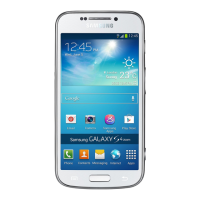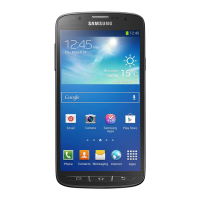Do you have a question about the Samsung Galaxy S4mini and is the answer not in the manual?
Initial setup and basic operations for new users.
Explains how the manual is organized and special text conventions used.
Defines special text formatting like Note, Tip, Important, and Warning.
Guides on installing SIM, battery, and memory card.
Instructions on how to remove the back cover for component access.
Step-by-step guide for inserting the SIM card correctly.
Instructions for inserting an optional microSD memory card.
Details on how to insert the Li-Ion battery correctly.
Instructions on how to properly reattach the battery cover.
Steps for connecting the charger and charging the device.
Explains the meaning of the battery icon in the status bar.
How to power the device on and off using the Power/Lock key.
Guides through the initial setup process after powering on.
Overview of screen lock features to secure the device.
How to manually lock the device using the Power/Lock Key.
Methods for unlocking the device using lock screens.
Lists key specifications and features of the device.
Identifies and describes the front components and buttons of the phone.
Identifies and describes the back components and ports of the phone.
Explains the Home screen as the starting point for device usage.
Describes how the Home screen panels extend beyond the display width.
How to customize the Home screen by adding or removing panels.
Explains the icons and information displayed in the Status Bar.
Details the meaning of various network, connection, and notification icons.
How to access and use the Notification Panel for alerts and settings.
Steps to clear individual or all notifications from the panel.
Accessing and using Quick Settings for popular configurations.
Steps for customizing the Home screen by adding shortcuts and widgets.
Defines shortcuts and widgets and how to manage them.
Process for adding shortcuts and widgets to the Home screen.
How to remove shortcuts or widgets from the Home screen.
Instructions for creating and using folders on the Home screen.
How to choose and set wallpaper for the Home and Lock screens.
Using gestures and motions to navigate device features.
Explains basic touch and touch-and-hold gestures.
How to perform swipe gestures for navigation and actions.
Using pinch and spread gestures for zooming.
Using phone movements to navigate and access features.
How Smart Stay uses the front camera to keep the screen on.
Using voice commands to control the phone's functions.
Using the virtual QWERTY keyboard and voice input.
Overview of the three available text input methods.
How to select the default text input method via Settings.
How to change the input method while typing.
Overview of synchronizing information from various accounts.
Setting up a Google account for Android features.
Creating a Samsung account for app access.
Step-by-step guide to adding and managing accounts.
Options for managing existing accounts, sync, and settings.
Using the Contacts app to store and manage contact information.
Ways to access the Contacts application on the device.
Helpful tips for quick dialing, messaging, and list navigation.
Detailed steps for creating a new contact with various fields.
How to edit and update existing contact information.
Creating or updating contacts from recent call history.
Steps to mark and delete contacts from the device.
Options for choosing which contacts to display and contact settings.
Accessing options like import/export, sharing, and speed dial.
Methods for sharing contact details via various services.
Marking contacts as Favorites for quick access.
How to access the Favorites list within Contacts or Phone apps.
Steps to add contacts to the Favorites list.
How to remove contacts from the Favorites list.
Assigning contacts to groups for faster searching and messaging.
Steps to create new contact groups with custom settings.
Process for adding contacts to an existing group.
Steps to remove contacts from a group.
Overview of multiple ways to make calls on the device.
How to dial numbers directly using the on-screen keypad.
Using assigned speed dial numbers to quickly call contacts.
How to make calls directly from the Contacts list.
Placing calls using voice commands with S Voice.
Calling contacts marked as favorites.
Returning calls or calling from the recent calls list.
Setting up conference calls with multiple participants.
How to answer incoming calls when the device is locked or unlocked.
Options for rejecting calls and sending messages or to voicemail.
How to reject an incoming call using the Reject icon.
Rejecting calls and sending a pre-defined or custom message.
Managing incoming calls while already on a call.
Using features like Add call, Keypad, Speaker, Mute during a call.
How to terminate an active phone call.
Accessing records of placed, answered, or missed calls.
How to redial or call contacts from the Recent Calls list.
Sending text messages to numbers found in recent calls.
Adding new or updating existing contacts from recent calls.
Options for managing the list of recent calls.
How to delete individual or all call records.
Filtering call records by type (all, missed, dialed, etc.).
Viewing the length of last call, dialed, or received calls.
Lists the different types of messages supported by the phone.
How new messages are notified via ringtone, vibrate, or status bar.
Steps to compose and send text and multimedia messages.
Additional options available when composing messages (emoticons, attachments).
How messages are grouped into conversations (threads).
How to read and view message details and content.
How to reply to an incoming message.
Steps to delete individual messages or entire message threads.
How to lock messages to prevent accidental deletion.
Accessing options like search, delete threads, and message settings.
How to configure settings for text and multimedia messages.
Configuring settings to filter incoming messages for spam.
How to enable/disable emergency alerts received via CMAS.
Overview of managing installed applications on the device.
Accessing all installed applications via the Apps screen.
Finding and installing new applications from stores.
How to remove downloaded applications from the phone.
How to use the built-in calculator for mathematical calculations.
Recording events and appointments to manage schedules.
Sharing calendar events as vCalendar files or attachments.
Using the camera to take and share pictures and videos.
Important precautions regarding taking photos of people and in restricted areas.
Steps for composing and capturing photos with the camera.
How to record, view, and send videos using the phone's camera.
Choosing special options to enhance pictures and videos.
Quickly configuring settings for taking pictures and recording videos.
Configuring default options for photos and videos.
Using ChatON for text, image, and video sharing with friends.
Using Google Chrome to browse the web.
Displaying city/state for calls and looking up phone numbers.
Features of the Clock app, including alarms, world clock, and stopwatch.
Viewing and managing files downloaded to the phone.
Using Dropbox for cloud file storage and syncing.
Sending and receiving email using popular email services.
Creating a personalized digital magazine from shared information.
Automatically saving photos to Google+ account for organization.
Viewing pictures and videos taken with the camera or stored on memory cards.
Browsing and viewing photos and videos within albums.
Using the built-in photo editor for basic editing functions.
Methods for zooming in or out on photos using touch gestures.
Using Google to search the web.
Using Google Now for automatic updates based on user actions.
Configuring preferences for Google+ and other Google services.
Connecting and sharing with friends using Google+.
Sharing documents, photos, or music with nearby devices via Wi-Fi.
Using Hangouts for instant messaging and video calls.
Accessing information to learn about the device.
Accessing the internet using the phone's browser.
Using command keys and gestures for web browsing.
Displaying the keyboard to enter text in web fields.
Zooming in or out on web pages using touch gestures.
Selecting items and following hyperlinks on web pages.
Accessing websites by entering URLs into the browser.
Using location services to find destinations and places.
Using Google Maps for directions and location-based information.
Sending and receiving text and multimedia messages.
Using Wi-Fi for wireless networking and internet access.
Steps to enable or disable Wi-Fi connectivity.
How to find available Wi-Fi networks and connect to them.
Manually adding a new Wi-Fi network with specific settings.
Configuring advanced wireless access point settings.
Connecting devices directly via Wi-Fi without a network.
Steps to enable Wi-Fi Direct for device-to-device connections.
How to disable Wi-Fi Direct and end connections.
Connecting the phone to other Wi-Fi Direct compatible devices.
Using Bluetooth for short-range wireless communication.
Steps to enable or disable Bluetooth on the device.
Connecting the phone to a Bluetooth device via pairing.
Disconnecting or removing paired Bluetooth devices.
Configuring visibility, renaming, and other Bluetooth options.
Sharing the phone's data connection via USB, Wi-Fi, or Bluetooth.
Using the phone as an internet access point via Wi-Fi hotspot.
Steps to enable and configure the portable Wi-Fi hotspot.
Connecting other devices to the phone's Wi-Fi hotspot.
Managing the list of devices allowed to connect to the hotspot.
Configuring hotspot name, security, and channel.
Sharing mobile data connection via Bluetooth.
Setting up and managing Virtual Private Networks (VPNs).
Using NFC for information sharing between devices via Android Beam or S Beam.
Enabling or disabling NFC functionality on the device.
Sharing smaller files using NFC and Android Beam.
Sharing larger files using NFC and S Beam.
Sharing files with nearby devices using DLNA standard via Wi-Fi.
Controlling content sharing, allowed devices, and download locations.
Sharing phone media files on an HDMI device like a TV.
Connecting to Kies program on desktop computer via Wi-Fi.
How to open the Settings menu from Home screen or Notification Panel.
Explains the four main tabs in the Settings menu (Connections, My device, Accounts, More).
Managing the device's Wi-Fi connections.
Connecting devices directly via Wi-Fi without a network.
Using Bluetooth for short-range wireless communication.
Monitoring and controlling phone's connection to mobile data service.
Charting total mobile data usage and breakdown by application.
Setting data limits and warnings to manage usage.
Accessing additional connection configurations for phone and devices.
Turning off calling, messaging, and data features for flights.
Setting options for network selection and data service.
Sharing the phone's data connection via USB, Wi-Fi, or Bluetooth.
Setting up and managing Virtual Private Networks (VPNs).
Using NFC for information sharing between devices.
Sharing smaller files using NFC and Android Beam.
Sharing larger files using NFC and S Beam.
Sharing files with nearby devices using DLNA standard via Wi-Fi.
Sharing phone media files on an HDMI device like a TV.
Connecting to Kies program on desktop computer via Wi-Fi.
Choosing settings to unlock your phone.
Selecting and configuring various screen lock methods.
Unlocking the phone by swiping a finger across the screen.
Unlocking the phone using facial recognition and voice commands.
Unlocking the phone by looking at the screen.
Drawing a pattern on the screen to unlock the phone.
Using a numeric PIN to unlock the phone.
Using an alphanumeric password to unlock the phone.
Configuring settings for the phone's display.
Customizing the background of the Home and Lock screens.
Configuring options for the Notification panel.
Choosing a screen mode to match viewing preferences.
Adjusting screen brightness for surroundings or preference.
Allowing the phone to switch display orientation automatically.
Setting the time period for the screen to remain lit.
Controlling screen display when the phone is docked or charging.
Selecting the font style for standard display text.
Selecting the font size for standard display text.
Setting the duration for Menu and Back Key lights.
Displaying the battery icon plus the percentage of remaining charge.
Automatically opening screen captures for editing.
Automatically adjusting screen brightness to conserve battery.
Turning on LED lights for charging, missed events, and notifications.
Configuring sound and audio settings for the phone.
Setting system volume level for calls, notifications, and media.
Choosing a ringtone for incoming calls.
Choosing a vibration pattern for calls and notifications.
Setting a default sound for notifications like messages and reminders.
Enabling vibration for calls and notifications along with ringtone.
Playing tones when touching keys on the phone keypad.
Playing tones when touching keys on the phone.
Playing tones when touching the screen to lock or unlock.
Choosing a tone or vibration for emergency calls.
Choosing between Standard and Easy modes for the Home screen.
Finding the best sound for calls and media playback using earphones.
Configuring various calling options for the device.
Managing a list of phone numbers to be automatically rejected.
Creating and managing text messages for rejecting incoming calls.
Managing settings for answering and ending calls.
Automatically turning off the screen during phone calls.
Setting sounds and vibrations for events during calls.
Configuring options for using a headset.
Suppressing background noise during calls.
Increasing ringtone volume when the phone is in a pocket or bag.
Configuring options for voicemail service and settings.
Adding accounts to share information between phone and account.
Configuring options for synchronizing and backing up data using online storage.
Backing up application data, passwords, and settings.
Enabling automatic backup of data to a Google Account.
Resetting all settings to factory defaults and deleting all data.
Configuring how the phone determines its location.
Information on Radio Frequency (RF) exposure from wireless phones.
Discusses concerns and scientific evidence regarding cell phone radiation.
Information about a study on cell phones and head/neck cancer risk.
Details on a long-term study monitoring health issues linked to cell phone exposure.
Study investigating RF exposure and brain cancer in young people.
Cancer statistics tracking for brain cancer rates in the US.
Steps urged for the cell phone industry regarding RF exposure.
Steps to minimize RF exposure, including using hands-free kits.
Information on hands-free kits and their role in reducing RF exposure.
Discusses the effectiveness of accessories claiming to shield from RF radiation.
Safety advice for children regarding cell phone RF exposure.
FCC RF exposure limits and SAR certification details for the phone.
User information regarding FCC Rules, interference, and operation.
Guidelines for safe mobile device usage while operating a vehicle.
Important information on handling and storing batteries to avoid injury or damage.
Samsung's commitment to recycling mobile devices and batteries.
Safety instructions for the UL certified travel charger.
Notes on touch-screen response and potential damage.
How the device uses GPS for location-based applications.
How to make emergency calls and ensure location accuracy.
Suggestions for maintaining the mobile device's quality and function.
Precautions regarding liquids, heat, microwaves, dust, and cleaning.
Advice on handling the device to prevent damage from drops or shocks.
Warning against painting the mobile device as it can clog parts.
Caution regarding potential hearing loss from loud sounds.
Precautions for using the device near medical implants like pacemakers.
Advice for using the device near other personal medical devices.
Potential RF signal interference with vehicle electronic systems.
Instructions to switch off the device in posted facilities.
Precautions for using the device in areas with potentially explosive atmospheres.
Procedures to follow if the device becomes wet.
FCC requirements for wireless device compatibility with hearing aids.
Explains M-ratings for less interference with hearing devices.
Explains T-ratings for inductive coupling with hearing aids.
FCC notice about potential TV or radio interference.
Warnings about unauthorized modifications and proper usage.
Safety information regarding vehicle installations and aircraft usage.
Warning about potential seizures from flashing lights during video or gaming.
Advice to reduce discomfort from repetitive actions like typing or gaming.
Covers what the limited warranty includes and its duration.
Details the warranty period for the device and its accessories.
Lists exclusions and conditions under which the warranty is void.
Explains SAMSUNG's responsibilities for repair or replacement under warranty.
Steps required to obtain warranty service for the product.
Outlines the extent of SAMSUNG's responsibilities and liabilities for the product.
Explains the arbitration process for resolving disputes with SAMSUNG.
Instructions on how to opt out of the dispute resolution procedure.
States that if any warranty provision is unenforceable, the rest remain valid.
Recommendations for data removal and device return for EFS Clear.
Initial setup and basic operations for new users.
Explains how the manual is organized and special text conventions used.
Defines special text formatting like Note, Tip, Important, and Warning.
Guides on installing SIM, battery, and memory card.
Instructions on how to remove the back cover for component access.
Step-by-step guide for inserting the SIM card correctly.
Instructions for inserting an optional microSD memory card.
Details on how to insert the Li-Ion battery correctly.
Instructions on how to properly reattach the battery cover.
Steps for connecting the charger and charging the device.
Explains the meaning of the battery icon in the status bar.
How to power the device on and off using the Power/Lock key.
Guides through the initial setup process after powering on.
Overview of screen lock features to secure the device.
How to manually lock the device using the Power/Lock Key.
Methods for unlocking the device using lock screens.
Lists key specifications and features of the device.
Identifies and describes the front components and buttons of the phone.
Identifies and describes the back components and ports of the phone.
Explains the Home screen as the starting point for device usage.
Describes how the Home screen panels extend beyond the display width.
How to customize the Home screen by adding or removing panels.
Explains the icons and information displayed in the Status Bar.
Details the meaning of various network, connection, and notification icons.
How to access and use the Notification Panel for alerts and settings.
Steps to clear individual or all notifications from the panel.
Accessing and using Quick Settings for popular configurations.
Steps for customizing the Home screen by adding shortcuts and widgets.
Defines shortcuts and widgets and how to manage them.
Process for adding shortcuts and widgets to the Home screen.
How to remove shortcuts or widgets from the Home screen.
Instructions for creating and using folders on the Home screen.
How to choose and set wallpaper for the Home and Lock screens.
Using gestures and motions to navigate device features.
Explains basic touch and touch-and-hold gestures.
How to perform swipe gestures for navigation and actions.
Using pinch and spread gestures for zooming.
Using phone movements to navigate and access features.
How Smart Stay uses the front camera to keep the screen on.
Using voice commands to control the phone's functions.
Using the virtual QWERTY keyboard and voice input.
Overview of the three available text input methods.
How to select the default text input method via Settings.
How to change the input method while typing.
Overview of synchronizing information from various accounts.
Setting up a Google account for Android features.
Creating a Samsung account for app access.
Step-by-step guide to adding and managing accounts.
Options for managing existing accounts, sync, and settings.
Using the Contacts app to store and manage contact information.
Ways to access the Contacts application on the device.
Helpful tips for quick dialing, messaging, and list navigation.
Detailed steps for creating a new contact with various fields.
How to edit and update existing contact information.
Creating or updating contacts from recent call history.
Steps to mark and delete contacts from the device.
Options for choosing which contacts to display and contact settings.
Accessing options like import/export, sharing, and speed dial.
Methods for sharing contact details via various services.
Marking contacts as Favorites for quick access.
How to access the Favorites list within Contacts or Phone apps.
Steps to add contacts to the Favorites list.
How to remove contacts from the Favorites list.
Assigning contacts to groups for faster searching and messaging.
Steps to create new contact groups with custom settings.
Process for adding contacts to an existing group.
Steps to remove contacts from a group.
Overview of multiple ways to make calls on the device.
How to dial numbers directly using the on-screen keypad.
Using assigned speed dial numbers to quickly call contacts.
How to make calls directly from the Contacts list.
Placing calls using voice commands with S Voice.
Calling contacts marked as favorites.
Returning calls or calling from the recent calls list.
Setting up conference calls with multiple participants.
How to answer incoming calls when the device is locked or unlocked.
Options for rejecting calls and sending messages or to voicemail.
How to reject an incoming call using the Reject icon.
Rejecting calls and sending a pre-defined or custom message.
Managing incoming calls while already on a call.
Using features like Add call, Keypad, Speaker, Mute during a call.
How to terminate an active phone call.
Accessing records of placed, answered, or missed calls.
How to redial or call contacts from the Recent Calls list.
Sending text messages to numbers found in recent calls.
Adding new or updating existing contacts from recent calls.
Options for managing the list of recent calls.
How to delete individual or all call records.
Filtering call records by type (all, missed, dialed, etc.).
Viewing the length of last call, dialed, or received calls.
Lists the different types of messages supported by the phone.
How new messages are notified via ringtone, vibrate, or status bar.
Steps to compose and send text and multimedia messages.
Additional options available when composing messages (emoticons, attachments).
How messages are grouped into conversations (threads).
How to read and view message details and content.
How to reply to an incoming message.
Steps to delete individual messages or entire message threads.
How to lock messages to prevent accidental deletion.
Accessing options like search, delete threads, and message settings.
How to configure settings for text and multimedia messages.
Configuring settings to filter incoming messages for spam.
How to enable/disable emergency alerts received via CMAS.
Overview of managing installed applications on the device.
Accessing all installed applications via the Apps screen.
Finding and installing new applications from stores.
How to remove downloaded applications from the phone.
How to use the built-in calculator for mathematical calculations.
Recording events and appointments to manage schedules.
Sharing calendar events as vCalendar files or attachments.
Using the camera to take and share pictures and videos.
Important precautions regarding taking photos of people and in restricted areas.
Steps for composing and capturing photos with the camera.
How to record, view, and send videos using the phone's camera.
Choosing special options to enhance pictures and videos.
Quickly configuring settings for taking pictures and recording videos.
Configuring default options for photos and videos.
Using ChatON for text, image, and video sharing with friends.
Using Google Chrome to browse the web.
Displaying city/state for calls and looking up phone numbers.
Features of the Clock app, including alarms, world clock, and stopwatch.
Viewing and managing files downloaded to the phone.
Using Dropbox for cloud file storage and syncing.
Sending and receiving email using popular email services.
Creating a personalized digital magazine from shared information.
Automatically saving photos to Google+ account for organization.
Viewing pictures and videos taken with the camera or stored on memory cards.
Browsing and viewing photos and videos within albums.
Using the built-in photo editor for basic editing functions.
Methods for zooming in or out on photos using touch gestures.
Using Google to search the web.
Using Google Now for automatic updates based on user actions.
Configuring preferences for Google+ and other Google services.
Connecting and sharing with friends using Google+.
Sharing documents, photos, or music with nearby devices via Wi-Fi.
Using Hangouts for instant messaging and video calls.
Accessing information to learn about the device.
Accessing the internet using the phone's browser.
Using command keys and gestures for web browsing.
Displaying the keyboard to enter text in web fields.
Zooming in or out on web pages using touch gestures.
Selecting items and following hyperlinks on web pages.
Accessing websites by entering URLs into the browser.
Using location services to find destinations and places.
Using Google Maps for directions and location-based information.
Sending and receiving text and multimedia messages.
Using Wi-Fi for wireless networking and internet access.
Steps to enable or disable Wi-Fi connectivity.
How to find available Wi-Fi networks and connect to them.
Manually adding a new Wi-Fi network with specific settings.
Configuring advanced wireless access point settings.
Connecting devices directly via Wi-Fi without a network.
Steps to enable Wi-Fi Direct for device-to-device connections.
How to disable Wi-Fi Direct and end connections.
Connecting the phone to other Wi-Fi Direct compatible devices.
Using Bluetooth for short-range wireless communication.
Steps to enable or disable Bluetooth on the device.
Connecting the phone to a Bluetooth device via pairing.
Disconnecting or removing paired Bluetooth devices.
Configuring visibility, renaming, and other Bluetooth options.
Sharing the phone's data connection via USB, Wi-Fi, or Bluetooth.
Using the phone as an internet access point via Wi-Fi hotspot.
Steps to enable and configure the portable Wi-Fi hotspot.
Connecting other devices to the phone's Wi-Fi hotspot.
Managing the list of devices allowed to connect to the hotspot.
Configuring hotspot name, security, and channel.
Sharing mobile data connection via Bluetooth.
Setting up and managing Virtual Private Networks (VPNs).
Using NFC for information sharing between devices via Android Beam or S Beam.
Enabling or disabling NFC functionality on the device.
Sharing smaller files using NFC and Android Beam.
Sharing larger files using NFC and S Beam.
Sharing files with nearby devices using DLNA standard via Wi-Fi.
Controlling content sharing, allowed devices, and download locations.
Sharing phone media files on an HDMI device like a TV.
Connecting to Kies program on desktop computer via Wi-Fi.
How to open the Settings menu from Home screen or Notification Panel.
Explains the four main tabs in the Settings menu (Connections, My device, Accounts, More).
Managing the device's Wi-Fi connections.
Connecting devices directly via Wi-Fi without a network.
Using Bluetooth for short-range wireless communication.
Monitoring and controlling phone's connection to mobile data service.
Charting total mobile data usage and breakdown by application.
Setting data limits and warnings to manage usage.
Accessing additional connection configurations for phone and devices.
Turning off calling, messaging, and data features for flights.
Setting options for network selection and data service.
Sharing the phone's data connection via USB, Wi-Fi, or Bluetooth.
Setting up and managing Virtual Private Networks (VPNs).
Using NFC for information sharing between devices.
Sharing smaller files using NFC and Android Beam.
Sharing larger files using NFC and S Beam.
Sharing files with nearby devices using DLNA standard via Wi-Fi.
Sharing phone media files on an HDMI device like a TV.
Connecting to Kies program on desktop computer via Wi-Fi.
Choosing settings to unlock your phone.
Selecting and configuring various screen lock methods.
Unlocking the phone by swiping a finger across the screen.
Unlocking the phone using facial recognition and voice commands.
Unlocking the phone by looking at the screen.
Drawing a pattern on the screen to unlock the phone.
Using a numeric PIN to unlock the phone.
Using an alphanumeric password to unlock the phone.
Configuring settings for the phone's display.
Customizing the background of the Home and Lock screens.
Configuring options for the Notification panel.
Choosing a screen mode to match viewing preferences.
Adjusting screen brightness for surroundings or preference.
Allowing the phone to switch display orientation automatically.
Setting the time period for the screen to remain lit.
Controlling screen display when the phone is docked or charging.
Selecting the font style for standard display text.
Selecting the font size for standard display text.
Setting the duration for Menu and Back Key lights.
Displaying the battery icon plus the percentage of remaining charge.
Automatically opening screen captures for editing.
Automatically adjusting screen brightness to conserve battery.
Turning on LED lights for charging, missed events, and notifications.
Configuring sound and audio settings for the phone.
Setting system volume level for calls, notifications, and media.
Choosing a ringtone for incoming calls.
Choosing a vibration pattern for calls and notifications.
Setting a default sound for notifications like messages and reminders.
Enabling vibration for calls and notifications along with ringtone.
Playing tones when touching keys on the phone keypad.
Playing tones when touching keys on the phone.
Playing tones when touching the screen to lock or unlock.
Choosing a tone or vibration for emergency calls.
Choosing between Standard and Easy modes for the Home screen.
Finding the best sound for calls and media playback using earphones.
Configuring various calling options for the device.
Managing a list of phone numbers to be automatically rejected.
Creating and managing text messages for rejecting incoming calls.
Managing settings for answering and ending calls.
Automatically turning off the screen during phone calls.
Setting sounds and vibrations for events during calls.
Configuring options for using a headset.
Suppressing background noise during calls.
Increasing ringtone volume when the phone is in a pocket or bag.
Configuring options for voicemail service and settings.
Adding accounts to share information between phone and account.
Configuring options for synchronizing and backing up data using online storage.
Backing up application data, passwords, and settings.
Enabling automatic backup of data to a Google Account.
Resetting all settings to factory defaults and deleting all data.
Configuring how the phone determines its location.
Information on Radio Frequency (RF) exposure from wireless phones.
Discusses concerns and scientific evidence regarding cell phone radiation.
Information about a study on cell phones and head/neck cancer risk.
Details on a long-term study monitoring health issues linked to cell phone exposure.
Study investigating RF exposure and brain cancer in young people.
Cancer statistics tracking for brain cancer rates in the US.
Steps urged for the cell phone industry regarding RF exposure.
Steps to minimize RF exposure, including using hands-free kits.
Information on hands-free kits and their role in reducing RF exposure.
Discusses the effectiveness of accessories claiming to shield from RF radiation.
Safety advice for children regarding cell phone RF exposure.
FCC RF exposure limits and SAR certification details for the phone.
User information regarding FCC Rules, interference, and operation.
Guidelines for safe mobile device usage while operating a vehicle.
Important information on handling and storing batteries to avoid injury or damage.
Samsung's commitment to recycling mobile devices and batteries.
Safety instructions for the UL certified travel charger.
Notes on touch-screen response and potential damage.
How the device uses GPS for location-based applications.
How to make emergency calls and ensure location accuracy.
Suggestions for maintaining the mobile device's quality and function.
Precautions regarding liquids, heat, microwaves, dust, and cleaning.
Advice on handling the device to prevent damage from drops or shocks.
Warning against painting the mobile device as it can clog parts.
Caution regarding potential hearing loss from loud sounds.
Precautions for using the device near medical implants like pacemakers.
Advice for using the device near other personal medical devices.
Potential RF signal interference with vehicle electronic systems.
Instructions to switch off the device in posted facilities.
Precautions for using the device in areas with potentially explosive atmospheres.
Procedures to follow if the device becomes wet.
FCC requirements for wireless device compatibility with hearing aids.
Explains M-ratings for less interference with hearing devices.
Explains T-ratings for inductive coupling with hearing aids.
FCC notice about potential TV or radio interference.
Warnings about unauthorized modifications and proper usage.
Safety information regarding vehicle installations and aircraft usage.
Warning about potential seizures from flashing lights during video or gaming.
Advice to reduce discomfort from repetitive actions like typing or gaming.
Covers what the limited warranty includes and its duration.
Details the warranty period for the device and its accessories.
Lists exclusions and conditions under which the warranty is void.
Explains SAMSUNG's responsibilities for repair or replacement under warranty.
Steps required to obtain warranty service for the product.
Outlines the extent of SAMSUNG's responsibilities and liabilities for the product.
Explains the arbitration process for resolving disputes with SAMSUNG.
Instructions on how to opt out of the dispute resolution procedure.
States that if any warranty provision is unenforceable, the rest remain valid.
Recommendations for data removal and device return for EFS Clear.
| Display Size | 4.3 inches |
|---|---|
| Resolution | 540 x 960 pixels |
| RAM | 1.5 GB |
| Internal Storage | 8 GB |
| Main Camera | 8 MP |
| Front Camera | 1.9 MP |
| Battery Capacity | 1900 mAh |
| Display Type | Super AMOLED |
| Expandable Storage | microSD, up to 64 GB |
| Dimensions | 124.6 x 61.3 x 8.9 mm |
| Weight | 107 g |
| Operating System | Android 4.2.2 (Jelly Bean) |











